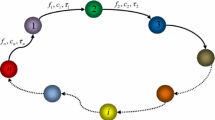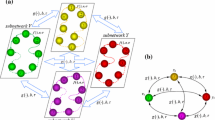Abstract
Although it is known that two coupled Wilson–Cowan models with reciprocal connections induce aperiodic oscillations, little attention has been paid to the dynamical mechanism for such oscillations so far. In this study, we aim to elucidate the fundamental mechanism to induce the aperiodic oscillations in the coupled model. First, aperiodic oscillations observed are investigated for the case when the connections are unidirectional and when the input signal is a periodic oscillation. By the phase portrait analysis, we determine that the aperiodic oscillations are caused by periodically forced state transitions between a stable equilibrium and a stable limit cycle attractors around the saddle-node and saddle separatrix loop bifurcation points. It is revealed that the dynamical mechanism where the state crosses over the saddle-node and saddle separatrix loop bifurcations significantly contributes to the occurrence of chaotic oscillations forced by a periodic input. In addition, this mechanism can also give rise to chaotic oscillations in reciprocally connected Wilson–Cowan models. These results suggest that the dynamic attractor transition underlies chaotic behaviors in two coupled Wilson–Cowan oscillators.











Similar content being viewed by others
References
Aronson G, Chory A, Hall R, McGehee P (1982) Bifurcations from an invariant circle for two-parameter families of maps of the plane: a computer-assisted study. Commun Math Phys 83(3):303–354
Borisyuk G, Borisyuk R, Khibnik A, Roose D (1995) Dynamics and bifurcations of two coupled neural oscillators with different connection types. Bull Math Biol 57(6):809–840
Borisyuk R, Kirillov A (1992) Bifurcation analysis of a neural network model. Biol Cybern 66(4):319–325
Decker R, Noonburg V (2012) A periodically forced Wilson–Cowan system with multiple attractors. SIAM J Appl Dyn Syst 44(2):887–905
Ermentrout G (2005) Neural oscillators. In: Borisyuk A, Ermentrout G, Friedman A, Terman D (eds) Tutorials in mathematical biosciences. Springer, Berlin, pp 69–106
Glazier A, Libchaber A (1988) Quasi-periodicity and dynamical systems: an experimentalist’s view. IEEE Trans Circuits Syst 35(7):790–809
Golubitsky M, Postlethwaite C (2012) Feed-forward networks, center manifolds, and forcing. Discret Contin Dyn Syst 32(8):2913–2935
Golubitsky M, Shiau L, Postlethwaite C, Zhang Y (2009) The feed-forward chain as a filter-amplifier motif. In: Josic K, Rubin J, Matias M, Romo R (eds) Coherent behavior in neuronal networks. Springer, New York, pp 95–120
Guckenheimer J, Holmes P (1983) Nonlinear oscillations, dynamical systems, and bifurcations of vector fields. Springer, New York
Hoppensteadt F, Izhikevich E (1997) Weakly connected neural networks. Springer, New York
Hoppensteadt F, Izhikevich E (1998) Thalamo-cortical interactions modeled by weakly connected oscillators: could the brain use FM radio principles? Biosystems 48(1–3):85–94
Izhikevich E (1999) Weakly connected quasi-periodic oscillators, FM interactions, and multiplexing in the brain. SIAM J Appl Math 59(6):2193–2223
Izhikevich E (2007) Dynamical systems in neuroscience. The MIT Press, Cambridge, MA
Kopell N, Ermentrout G (2002) Mechanisms of phaselocking and frequency control in pairs of coupled neural oscillators. In: Fiedler B, Ioos G, Kopell N (eds) Handbook of dynamical systems: toward applications, vol 3. Elsevier, Amsterdam, pp 3–54
Kuznetsov Y (1998) Elements of applied bifurcation theory. Springer, Berlin
Ledoux E, Brunel N (2011) Dynamics of networks of excitatory and inhibitory neurons in response to time-dependent inputs. Front Comput Neurosci 5(25): 1–17
Liske B, Schwarz M, Stevens A (2006) Neural pattern dynamics in an oscillator model of the thalamoreticular system. J Physiol Paris 99(1):66–71
Muir A (1979) A simple case of the Wilson–Cowan equations. Biophys J 27(2):267–275
Noonburg V, Benardete D, Pollina B (2003) A periodically forced Wilson–Cowan system. SIAM J Appl Dyn Syst 63(5):1585–1603
Pikovsky A, Rosenblum M, Kurths J (2001) Synchronization: a universal concept in nonlinear sciences. Cambridge University Press, Cambridge, MA
Sekikawa M, Shimizu K, Inaba N, Kita H, Endo T, Fujimoto K, Yoshinaga T, Aihara K (2011) Sudden change from chaos to oscillation death in the Bonhoeffer–van der Pol oscillator under weak periodic perturbation. Phys Rev E 84(5):056209
Shimizu K, Sekikawa M, Inaba N (2011) Mixed-mode oscillations and chaos from a simple second-order oscillator under weak periodic perturbation. Phys Lett A 375(14):1566–1569
Tsodyks M, Skaggs W, Sejnowski T, McNaughton B (1997) Paradoxical effects of external modulation of inhibitory interneurons. J Neurosci 17(11):4382–4388
Ueta T, Chen G (2003) On synchronization and control of coupled Wilson–Cowan neural oscillators. Int J Bifurc Chaos 13(1):163–175
von Bremen H, Udwadia F, Proskurowski W (1997) An efficient QR based method for the computation of Lyapunov exponents. Phys D 101(1–2):1–16
Wilson R, Cowan D (1972) Excitatory and inhibitory interactions in localized populations of neurons. Biophys J 12(1):153–170
Wilson R, Cowan D (1973) A mathematical theory of the functional dynamics of cortical and thalamic nervous tissue. Kybernetik 13(2):55–80
Author information
Authors and Affiliations
Corresponding author
Appendix: Summary of bifurcation analysis
Appendix: Summary of bifurcation analysis
The definitions and the methods of numerical analysis of each bifurcation are summarized. All the bifurcation sets shown in Fig. 2 are plotted by numerical calculation implemented by C program following the predictor–corrector method (Kuznetsov 1998). Fixed parameter values are the same as described in Sect. 2.3.
1.1 Andronov–Hopf bifurcation
Let us consider the Wilson–Cowan oscillator represented in the following form:
The Jacobian matrix of this system is defined as follows:
In the two-dimensional system, the AH bifurcation occurs when two eigenvalues of the Jacobian matrix at an equilibrium change into pure imaginary numbers. This is satisfied when \(\mathrm{Tr} \, J = 0\) and \(\mathrm{Det} \, J > 0\), where \(\mathrm{Tr}\) is the sum of diagonal elements of the matrix and \(\mathrm{Det}\) is the determinant of the matrix. Therefore, the AH bifurcation set (the red solid line in Fig. 2) is a set of points which satisfy the conditions below:
If \(\mathrm{Det}\,J(E, I, P, Q) < 0\), and the other conditions are satisfied, the AH bifurcation does not occur because the two eigenvalues of \(J\) are not pure imaginary numbers but real numbers. Such points are called neutral saddles, at which the sum of two real eigenvalues (saddle quantity) is equal to \(0\).
1.2 Saddle-node bifurcation
In the two-dimensional system, the SN bifurcation occurs when the determinant of \(J\) at an equilibrium is equal to \(0\). Therefore, the SN bifurcation set (the green line in Fig. 2) is a set of points which satisfy the conditions below:
1.3 Saddle separatrix loop bifurcation
There is a case that the stable manifold \(W^s\) and unstable manifold \(W^u\) conjoin in the phase space at a certain parameter value. If these manifolds both originate from the same saddle equilibrium, such a conjoint orbit is the saddle separatrix loop. The parameter values at which the saddle separatrix loop occurs are SSL bifurcation points, where a slight change in the parameter produces a stable limit cycle if the saddle quantity is less than \(0\).
Let us consider a surface \({\varSigma }\) which crosses over \(W^s\) originating from the saddle equilibrium. In terms of a coordinate \(\xi \) on \({\varSigma }\), the origin \(\xi = 0\) is assumed to correspond to the intersection of \({\varSigma }\) and \(W^s\) and \(\xi ^u\) is assumed to correspond to the intersection of \({\varSigma }\) and \(W^u\) originating from the same saddle equilibrium. \(\xi ^u\) is a function of \(E\), \(I\), \(P\), and \(Q\):
is called a split function. Obviously, \({\varXi } = 0\) when the saddle separatrix loop exists. Therefore, the SSL bifurcation set (the purple line in Fig. 2) is a set of points which satisfy the conditions below:
In the numerical calculation, \(W^s\) and \(W^u\) are replaced by the eigenvectors of \(J(E, I, P, Q)\) at the saddle equilibrium point which correspond to the negative and the positive eigenvalues, respectively. Orthogonalization of the orbit linearized near the equilibrium, and each eigenvector is the condition of the existence of a homoclinic orbit.
Rights and permissions
About this article
Cite this article
Maruyama, Y., Kakimoto, Y. & Araki, O. Analysis of chaotic oscillations induced in two coupled Wilson–Cowan models. Biol Cybern 108, 355–363 (2014). https://doi.org/10.1007/s00422-014-0604-8
Received:
Accepted:
Published:
Issue Date:
DOI: https://doi.org/10.1007/s00422-014-0604-8




